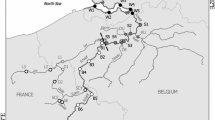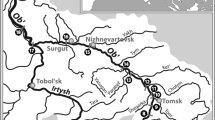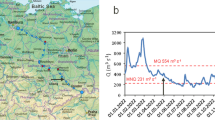Abstract
The longitudinal dynamics of Rotifers in the Potamal region of the River Elbe between Dresden, km 46, and Geesthacht, km 583, was investigated on a Lagrangian survey in 2000 which included transversal sampling (left bank, main channel, right bank) and sampling of five major tributaries and backwaters to evaluate lateral impacts on the zooplankton community. A simple model of longitudinal development for the dominant species Trichocerca pusilla was calculated, based on the results of an in situ incubation in Dresden and on literature data and compared with the dynamics observed on the Lagrangian survey. To characterize the influence of groyne fields on the main channel zooplankton community, an additional lateral sampling was conducted in August 2000 at Havelberg, km 423. Zooplankton community was clearly dominated by rotifers. A distinct downstream-directed increase of rotifers was observed. Longitudinal development of rotifers could be explained predominantly by reproduction during downstream transport.




Similar content being viewed by others
References
Adams, M. S., H. Kausch, T. Gaumert & K. E. Krueger, 1996. The effect of the reunification of Germany on the water chemistry and ecology of selected rivers. Environmental Conservation 23(1): 35–43.
Akopain, M., J. Garnier & R. Pourriot, 1999. A large reservoir as a source of zooplankton for the river: structure of the populations and influence of fish predation. Journal of Plankton Research 21(2): 285–298.
ARGE Elbe Wassergütedaten 1999, 2000. http//www.arge-elbe.de.
Baranyi, C., T. Hein, C. Holarek, S. Keckeis & F. Schiemer, 2002. Zooplankton biomass and community structure in a Danube River floodplain. Freshwater Biology 47: 473–482.
Bass, J. A. B., L. C. V. Pinder & D. V. Leach, 1997. Temporal and spatial variation in zooplankton populations in the River Great Ouse: An ephemeral food resource for larval and juvenil fish. Regulated Rivers-Research & Management 13(3): 245–258.
Basu, B. K. & F. R. Pick, 1996. Factors regulating phytoplankton and zooplankton biomass in temperate rivers. Limnology and. Oceanography, 41: 1572–1577.
Basu, B. K. & F. R. Pick, 1997. Phytoplankton and zooplankton development in a lowland temperate river. Journal of Plankton Research 19: 237–235.
Basu, B. K., J. Kalff & B. Pinel-Alloul, 2000a. Midsummer plankton development along a large temperate river: The St. Lawrence River. Canadian Journal of Aquatic Science 57: 7–15.
Basu, B. K., J. Kalff & B. Pinel-Alloul, 2000b. The influence of macrophyte beds on plankton communities and their export from fluvial lakes in the St Lawrence River. Freshwater Biology 45: 373–382.
de Ruyter van Steveninck E. D., W. Admiraal, L. Breebart, G. M. J. Tubbing, B. van Zanten, 1992. Plankton in the River Rhine: Structural and functional changes observed during downstream transport. Journal of Plankton Research 14(10): 1351–1368.
Desertovà, B., A. Prange & P. Punčochàř, 1996. Chlorophyll a concentrations along the River Elbe. Archives of Hydrobiology, Suppl. 113, Large Rivers, 10: 203–210.
Ferrari, I., A. Farabegoli & R. Mazzoni, 1989. Abundance and diversity of plankton rotifers in the Po River. Hydrobiologia, 186/187: 201–208.
Guhr, H., U. Dreyer & D. Spott, 1996. Changes in the water quality and macrozoobenthos in the River Elbe since 1989. Archives of Hydrobiology, Suppl. 113, Large Rivers 10: 1–4, 293–298.
Hein, T., G. Baranyi, C. Heiler, C. Holarek, P. Riedler & F. Schiemer, 1999. Hydrology as a major factor determining plankton development in two floodplain segments and the river Danube, Austria. Archives of Hydrobiology, Suppl. 115 (3), Large Rivers, 3: 439–452.
Holst, H., H. Zimmermann, H. Kausch & W. Koste, 1998. Temporal and spatial dynamics of planktonic rotifers in the Elbe Estuary during Spring. Estuarine Coastal and Shelf Science 47: 261–273.
Holst, H., H. Zimmermann-Timm & H. Kausch, 2002. Longitudinal and transverse distribution of plankton rotifers in the Potamal of the River Elbe (Germany) during late Summer. International Review of Hydrobiology 87: 267–280.
Jack, J. D. & J. H. Thorp, 2002. Impacts of fish predation on an Ohio River zooplankton community. Journal of Plankton Research 24(2): 119–127.
Karrasch, B., M. Mehrens, Y. Rosenlöcher & K. Peters, 2001. The dynamics of phytoplankton, bacteria and heterotrophic flagellates at two banks near Magdeburg in the River Elbe (Germany). Limnologica 31: 93–107.
Kim, H. W. & G. J. Joo, 2000. The longitudinal distribution and community dynamics of zooplankton in a regulated large river: a case study of the Nakdong River (Korea). Hydrobiologia 438: 171–184.
Kirk, K. L., 1991. Inorganic particles alter competition in grazing plankton: the role of selektive feeding. Ecology 71: 1741–1755.
Kirk, K. L. & J. J. Gilbert, 1990. Suspended clay and the population dynamics of planktonic rotifers and cladocerans. Ecology 7(5): 1741–1755.
Koste, W., 1978. Die Rädertiere Mitteleuropas. Begründet von Max Voigt. Gebrüder Bornträger Verlagsbuchhandlung Berlin, Stuttgart. Textband 1-8 and 1-673, Tafelband 1-234.
Lair, N., 2005. Abiotic vs. biotic factors: Lessons drawn from rotifers in the Middle Loire, a meandering river monitored from 1995 to 2002, during low flow periods. Hydrobiologia 546: 457–472.
Lair, N., V. Jaquet & P. Reyes-Marchant, 1999. Factors related to autotrophic potamoplankton, heterotrophic protists and micrometazoan abundance, at two sites in a lowland temperate river during low water flow. Hydrobiologia, 394: 13–28.
Lair, N. & P. Reyes-Marchant, 1997. The potamoplankton of the Middle Loire and the role of the ´moving littoral´ in downstream transfer of algae and rotifers. Hydrobiologia 356: 33–52.
May, L., & J. A. B. Bass, 1998. A study of rotifers in the River Thames, England, April–October, 1996. Hydrobiologia 387/388: 251–257.
Meister, A., 1994. Untersuchungen zum Plankton der Elbe und ihrer größeren Nebenflüsse. Limnologica 24(2): 153–214.
Miquelis, A., C. Rougier & R. Pourriot, 1998. Impact of turbulence and turbidity on the grazing rate of the rotifer Brachionus calyciflorus (Pallas). Hydrobiologia 386: 203–211.
Nusch, E. A., 1980. Comparison of different methods for chlorophyll and phaeopigment determination. Archives of Hydrobiology, Ergebnisse der Limnologie 14: 14–36.
Pejler, B. & B. Bērzinš, 1993. On the ecology of Trichocercidae (Rotifera). Hydrobiologia 263: 55–59.
Pourriot, R., C. Rougier & A. Miquelis, 1997. Origin and development of river zooplankton: Example of the Marne. Hydrobiologia 345: 143–148.
Reckendorfer, W., H. Keckeis, G. Winkler & F. Schiemer, 1999. Zooplankton abundance in the River Danube, Austria: The significance of inshore retention. Freshwater Biology 41: 583–591.
Reynolds, C. S., P. A. Carling & K. J. Beven, 1991. Flow in river channels: New insights into hydraulic retention. Archives of Hydrobiology 121(2): 171–179.
Reynolds, C. S. & M. S. Glaister, 1993. Spatial and temporal changes in phytoplankton abundance in the upper and middle reaches of the River Severn. Archives of Hydrobiology, Suppl. 101, Large Rivers 9: 1–22.
Schiemer, F., H. Keckeis, W. Reckendorfer & G. Winkler, 2001. The “inshore retention concept” and its significance for large rivers. Archives of Hydrobiology, Suppl. 135, Large Rivers 2–4: 509–516.
Spaink, P. A., T. Ietswaart & R. Roijackers, 1998. Plankton dynamics in a dead arm of the River Waal: A comparison with the main channel. Journal of Plankton Research 20(10): 1997–2007.
Sukhodolov, A., C. Engelhardt, H. Bungartz & A. Krüger, 2001. Flow structure in groyne fields: Case study on the River Elbe. Jahresforschungsbericht 2000 des IGB, Heft, Vol. 13, 27–34.
Thorp, J. H., A. R. Black, K. H. Haag & J. D. Wehr, 1994. Zooplankton assemblages in the Ohio River: Seasonal, tributary and navigation dam effects. Canadian Journal of Aquatic Science 51: 1634–1643.
Utermöhl, H., 1958. Zur Vervollkommnung der quantitativen Phytoplankton-Methodik. Mitteilungen der International Association of Theoretical and Applied Limnology 9: 1–38.
Van den Brink, F. W. B., M. M. Van Katwijk & G. Van der Velde, 1994. Impact of hydrology on phyto- and zooplankton community composition in floodplain lakes along the Lower River Rhine and Meuse. Journal of Plankton Research 16(4): 351–373.
Van Dijk, G. M. & B. Van Zanten, 1995. Seasonal changes in zooplankton abundance in the lower Rhine during 1987–1991. Hydrobiologia 304: 29–38.
Vannote, R. L., G. W. Minshall, K. W. Cummins, J. R. Sedell & C. E. Cushing, 1980. The River continuum concept. Canadian Journal of Aquatic Science 37: 130–137.
Viroux, L., 1997. Zooplankton development in two large lowland rivers, the Moselle (France) and the Meuse (Belgium), in 1993. Journal of Plankton Research 19(11): 1743–1762.
Viroux, L., 2002. Seasonal and longitudinal aspects of microcrustacean (Cladocera, Copepoda) dynamics in a lowland river. Journal of Plankton Research 24(4): 281–292.
Walz, N. & M. Welker, 1998. Plankton development in a rapidly flushed lake in the River Spree system (Neundörfer See, Northeast Germany). Journal of Plankton Research 20(11): 2071–2087.
Wehr, J. D. & J. H. Thorp, 1997. Effects of navigation dams, tributaries, and littoral zones on phytoplankton communities in the Ohio River. Canadian Journal of Aquatic Science 54: 378–395.
Welker, M. & N. Walz, 1999. Plankton dynamics in a river-lake system-on continuity and discontinuity. Hydrobiologia, 408/409: 233–239.
Zankai, N, 1989. Horizontal distribution of rotifer plankton along a trophic gradient in Lake Balaton: Changes in community structure and abundance during the past 20 years. Archives of Hydrobiology 115(1): 111–123.
Acknowledgments
We wish to thank U. Wörner, M. Steenbuck, S. Cummerow, A. Kakuschke (Hamburg) and S. Bühring (Bremen) for assistance in the field and laboratory, as well as J. Weiss (Jena) for analyzing phytoplankton samples. The authors greatly acknowledge the help of T. Hildebrandt (Hamburg) and M. Scholten (Berlin) for statistical assistance. We are also indebted to R. Eidner (BfG Berlin) for calculation of water transport time (QSIM, BfG Koblenz) and the ARGE Elbe for discharge and water temperature data. Thanks are due to A. Schlums (Potsdam) for linguistic improvements and two anonymous reviewers for helpful comments on the manuscript. The present study was supported by the federal BMBF-project TP0339606 “Stoffdynamik”of the research project “Elbe Ökologie”.
Author information
Authors and Affiliations
Corresponding author
Additional information
Guest editors: S. S. S. Sarma, R. D. Gulati, R. L. Wallace, S. Nandini, H. J. Dumont & R. Rico-Martinez
Advances in Rotifer Research
This paper is dedicated to Alois Herzig, a colleague and friend, on the occasion of his 60th birthday on May 24th, 2006.
Rights and permissions
About this article
Cite this article
Zimmermann-Timm, H., Holst, H. & Kausch, H. Spatial dynamics of rotifers in a large lowland river, the Elbe, Germany: How important are retentive shoreline habitats for the plankton community?. Hydrobiologia 593, 49–58 (2007). https://doi.org/10.1007/s10750-007-9046-9
Published:
Issue Date:
DOI: https://doi.org/10.1007/s10750-007-9046-9




